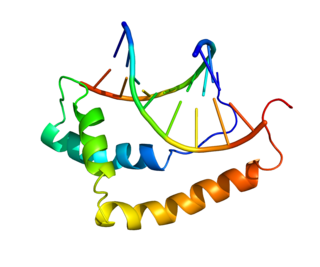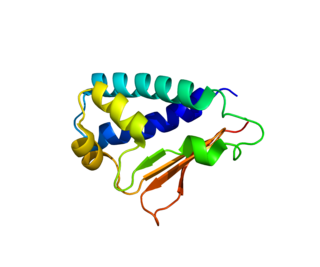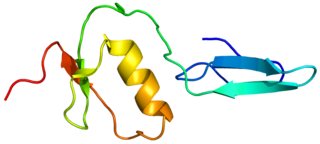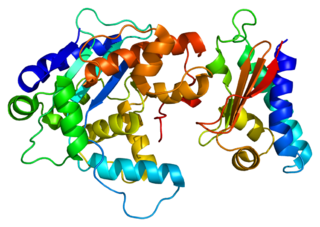Protein BTG1 is a protein that in humans is encoded by the BTG1 gene. [5] [6]
Protein BTG1 is a protein that in humans is encoded by the BTG1 gene. [5] [6]
The BTG1 gene locus has been shown to be involved in a t(8;12)(q24;q22) chromosomal translocation in a case of B-cell chronic lymphocytic leukemia. It is a member of a family of antiproliferative genes. BTG1 expression is maximal in the G0/G1 phases of the cell cycle and downregulated when cells progressed through G1. It negatively regulates cell proliferation. [6]
BTG1 has been shown to interact with:
Recurrent mutations in this gene have been associated to cases of diffuse large B-cell lymphoma. [13] [14]
Recent data, obtained in a new model of mouse lacking the BTG1 gene, indicate that BTG1 is essential for the proliferation and expansion of stem cells in the adult neurogenic niches, i.e. the dentate gyrus and sub ventricular zone (see for review [15] ). In particular, BTG1 keeps adult neural stem cells in quiescence, preserving the neural stem cells pool from depletion. In the absence of BTG1, the stem and progenitor cells initially hyper proliferate and then in the longer period lose the ability to proliferate and expand. [16] [17] Other recent data indicate that physical exercise can fully reconstitute the proliferative defect of stem cells that follows the ablation of the BTG1 gene, suggesting that the pool of neural stem cells maintains a hidden form of plasticity which is tightly controlled by BTG1; hence, BTG1 might prevent the depletion of stem cells in the presence of strong neurogenic stimuli or of neural degenerative stimuli. [18] [19]
Btg1 plays a role also in the expansion of cerebellar granule precursor cells. In fact the deletion of Btg1 leads in mouse to uncontrolled proliferation of the cerebellar precursor cells during the early postnatal period. Consequently, in the adult, the cerebellum lacking Btg1 is significantly larger and the motor coordination is heavily impaired. [20]
The closest homolog of BTG1 is BTG2, which also controls the proliferation and differentiation of adult neural stem cells; the role of BTG2, however, appears to differ from that of BTG1 being probably more relevant in controlling the terminal differentiation of neural stem and progenitor cells in the adult neurogenic niches. [17]

C-C chemokine receptor type 5, also known as CCR5 or CD195, is a protein on the surface of white blood cells that is involved in the immune system as it acts as a receptor for chemokines.

The PAX3 gene encodes a member of the paired box or PAX family of transcription factors. The PAX family consists of nine human (PAX1-PAX9) and nine mouse (Pax1-Pax9) members arranged into four subfamilies. Human PAX3 and mouse Pax3 are present in a subfamily along with the highly homologous human PAX7 and mouse Pax7 genes. The human PAX3 gene is located in the 2q36.1 chromosomal region, and contains 10 exons within a 100 kb region.

Chemokine ligand 3 (CXCL3) is a small cytokine belonging to the CXC chemokine family that is also known as GRO3 oncogene (GRO3), GRO protein gamma (GROg) and macrophage inflammatory protein-2-beta (MIP2b). CXCL3 controls migration and adhesion of monocytes and mediates its effects on its target cell by interacting with a cell surface chemokine receptor called CXCR2. More recently, it has been shown that Cxcl3 regulates cell autonomously the migration of the precursors of cerebellar granule neurons toward the internal layers of cerebellum, during the morphogenesis of cerebellum. Moreover, if the expression of Cxcl3 is reduced in cerebellar granule neuron precursors, this highly enhances the frequency of the medulloblastoma, the tumor of cerebellum. In fact, the reduced expression of Cxcl3 forces the cerebellar granule neuron precursors to remain at the surface of the cerebellum, where they highly proliferate under the stimulus of Sonic hedgehog, becoming target of transforming insults. Remarkably, the treatment with CXCL3 completely prevents the growth of medulloblastoma lesions in a Shh-type mouse model of medulloblastoma. Thus, CXCL3 is a target for medulloblastoma therapy. Cxcl3 is directly regulated transcriptionally by BTG2

Histone deacetylase 4, also known as HDAC4, is a protein that in humans is encoded by the HDAC4 gene.

SRY -box 2, also known as SOX2, is a transcription factor that is essential for maintaining self-renewal, or pluripotency, of undifferentiated embryonic stem cells. Sox2 has a critical role in maintenance of embryonic and neural stem cells.

Transcription factor SOX-9 is a protein that in humans is encoded by the SOX9 gene.

DNA-binding protein inhibitor ID-3 is a protein that in humans is encoded by the ID3 gene.

Protein BTG2 also known as BTG family member 2 or NGF-inducible anti-proliferative protein PC3 or NGF-inducible protein TIS21, is a protein that in humans is encoded by the BTG2 gene and in other mammals by the homologous Btg2 gene. This protein controls cell cycle progression and proneural genes expression by acting as a transcription coregulator that enhances or inhibits the activity of transcription factors.

Chromatin assembly factor 1 subunit A is a protein that in humans is encoded by the CHAF1A gene.

Follistatin-related protein 3 is a protein that in humans is encoded by the FSTL3 gene.

Homeobox protein Hox-C8 is a protein that in humans is encoded by the HOXC8 gene.

Protein Tob1 is a protein that in humans is encoded by the TOB1 gene.

Chromatin assembly factor 1 subunit B is a protein that in humans is encoded by the CHAF1B gene.

Homeobox protein Hox-B9 is a protein that in humans is encoded by the HOXB9 gene.

CCR4-NOT transcription complex subunit 7 is a protein that in humans is encoded by the CNOT7 gene. It is a subunit of the CCR4-Not deadenylase complex.

CCR4-NOT transcription complex subunit 8 is a protein that in humans is encoded by the CNOT8 gene. It is a subunit of the CCR4-Not deadenylase complex.

Protein BTG3 is a protein that in humans is encoded by the BTG3 gene.

Protein Tob2 is a protein that in humans is encoded by the TOB2 gene.

Zinc finger protein PLAGL2 is a protein that in humans is encoded by the PLAGL2 gene.

Protein BTG4 also known as BTG family member 4 is a protein that in humans is encoded by the BTG4 gene (B-cell translocation gene 4). BTG4 has anti-proliferative properties and can induce G1 cell cycle arrest.